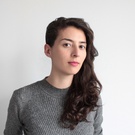
Judith Deschamps
.Biographie
Judith Deschamps est une artiste pluridisciplinaire française vivant entre la France et le Royaume-Uni. Formée à la Haute École des Arts du Rhin à Strasbourg (2011), au Royal College of Art à Londres (2018), et à l’École Universitaire de Recherche ArTeC à Paris (2020), elle engage depuis trois ans un travail sur la voix, dont les différents volets ont pris la forme d’installations sonores et sculpturales, et qui sont le fruit de gestes performatifs liés à l’histoire et à l’anatomie de l’appareil phonatoire.
Au carrefour entre plusieurs champs de savoir, sa pratique l’amène à collaborer avec des praticien·ne·s de diverses sciences et disciplines, et à exposer dans des institutions telles que le Casino Luxembourg, Luxembourg ; De Appel, Amsterdam ; le Frac Grand Large, Dunkerque ; le Centre Pompidou et le Musée d’Art et d’Histoire du Judaïsme, Paris ; Mains d’Œuvres, Saint-Ouen ; la Galerie Édouard Manet, Gennevilliers. Elle commencera un doctorat en automne 2021 à l’École Universitaire de Recherche ArTeC, sous la direction des Professeur·e·s Arnaud Regnauld et Laurence Devillers.
.Résidence en recherche artistique 2020.21
Quell'usignolo che innamorato : la résurgence d'une voix artificielle et profondément plurielle
Thématique de la recherche
Au croisement de l’art contemporain et de la recherche en transformation et synthèse de la voix chantée.
En résumé :
Recréation de la voix de Farinelli et d’un chant hybride au moyen de réseaux profonds.
En collaboration avec l'équipe Analyse et Synthèse des sons de l'Ircam-STMS
Quell’usignolo che innamorato (ce rossignol qui est en amour) est un chant que le castrat italien Farinelli aurait performé pour le roi d’Espagne Philippe V toutes les nuits, sur une période de dix ans, afin de calmer sa mélancolie.
Dans la continuité du projet de recréation de la voix de Farinelli par l’Ircam en 1994, cette résidence s’appuiera sur les avancées du traitement du signal vocal et de l’apprentissage profond pour recréer le chant en question. Il s’agira d’entraîner des réseaux profonds avec la voix de chanteurs et de chanteuses performant dans des hauteurs (pitch) différentes, et d’élaborer des méthodes permettant de produire un chant hybride, incorporant les spécificités de chaque voix à partir de paramètres de contrôle externes, ou automatiquement, en fonction de la hauteur chantée.
Au carrefour entre la voix d’un enfant, d’une femme et d’un homme d’âges adultes, nous chercherons à exprimer le caractère plastique et protéiforme de la voix de Farinelli, ses variations, ses nuances, et ses différentes temporalités. L’objectif de cette résidence sera d’explorer la potentialité transformative de l’intelligence artificielle, afin de créer une voix fictive (et non pas mimétique). Elle incorporera les « erreurs » et les limites de la technologie utilisée, afin de mettre en tension l’imaginaire transhumaniste que suscite une telle voix, avec la réalité de ses modes de fabrication.


